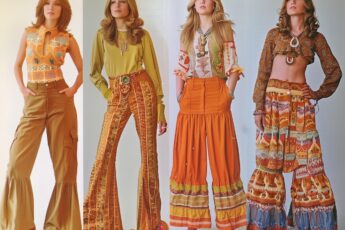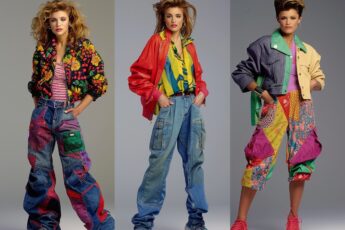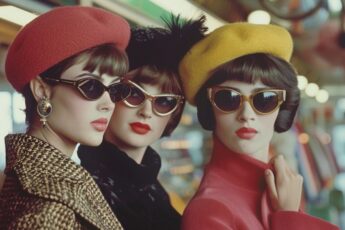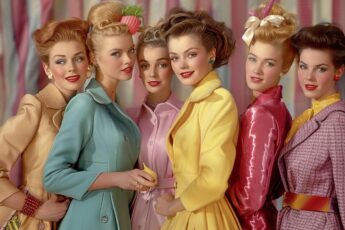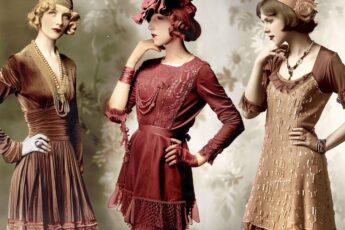The Vibrant World of 1980s Fashion
I’ve always been fascinated by the 1980s. This decade stands out as a pivotal moment in style evolution. When I think of 1980s fashion, I see a kaleidoscope of bold colors, exaggerated silhouettes, and diverse influences.
The 1980s brought us fashion that was anything but subtle. It was loud, it was proud, and it demanded attention. From the boardrooms of Wall Street to the streets of urban neighborhoods, fashion became a powerful form of self-expression.
Fashion is the armor to survive the reality of everyday life.
This quote perfectly encapsulates the 80s approach to style. People used clothing to stand out, make statements, and align themselves with various subcultures.
What made 80s fashion so unique? Here are a few key elements:
- Bold colors and neon hues
- Oversized and padded silhouettes
- The mix of high-end luxury and street-style
- Influence of music and pop culture on everyday wear
The economic prosperity of the era played a significant role in shaping fashion trends. People had more disposable income, and they weren’t afraid to spend it on designer labels and statement pieces.
But it wasn’t all about excess. The 80s also saw the rise of various subcultures, each with its own distinct style. From the power-dressing executives to the neon-clad party-goers, from punk rockers to preppy college students – the fashion landscape was incredibly diverse.
In my years studying fashion history, I’ve come to see the 1980s as a time of contradiction and creativity. It was a decade where anything went, as long as it was bold and eye-catching. As we dive deeper into the specific trends and influences of 80s fashion, we’ll explore how this decade continues to impact style even today.
Power Dressing: Corporate Influence on Fashion
The 1980s saw the rise of power dressing, a style that reflected the growing presence of women in corporate environments. I’ve always found this trend fascinating because it showcased how fashion could be used as a tool for professional advancement.
Power dressing centered around creating a strong, authoritative silhouette. Key elements included:
- Broad shoulders enhanced by padding
- Tailored suits for women
- Bold patterns like pinstripes
The goal was to project confidence and competence in the workplace. Women’s suits often mimicked men’s styles but with feminine touches. I noticed how this trend blurred gender lines in professional attire.
Dress for the job you want, not the job you have.
This popular saying encapsulates the philosophy behind power dressing. It wasn’t just about looking good; it was about commanding respect and being taken seriously in the corporate world.
Colors played a crucial role, too. While black, navy, and gray dominated, power dressers often incorporated bold reds or strong jewel tones to stand out. The overall effect was striking and memorable.
Accessories completed the power look:
- Statement jewelry, especially large earrings
- Structured handbags
- High heels
Power dressing wasn’t limited to women. Men’s fashion also embraced broader shoulders and bolder patterns. The power suit became a symbol of success for both genders.
Neon and Bold Colors: The Bright Side of 80s Style
If power dressing represented the serious side of 80s fashion, neon colors showcased its playful, exuberant nature. I find the neon trend particularly emblematic of the decade’s spirit.
Neon colors burst onto the scene, influenced by:
- The rise of MTV and music videos
- Advances in fabric dye technology
- A general mood of optimism and excess
These bright hues weren’t confined to one area of fashion. They appeared everywhere:
| Item | Neon Colors |
|---|---|
| T-shirts | Hot pink, electric blue |
| Accessories | Lime green, neon orange |
| Swimwear | Fluorescent yellow, vibrant purple |
The neon trend wasn’t subtle. It was about making a statement and being seen. I observed how it reflected the ‘bigger is better’ attitude of the 80s.
Life’s too short to blend in.
This quote captures the essence of the neon trend. People wanted to stand out, and these bold colors provided an easy way to do so.
Color blocking also gained popularity during this time. Designers and everyday people alike combined multiple bright colors in a single outfit, creating eye-catching ensembles.
The influence of pop culture on this trend can’t be overstated. Music videos, in particular, popularized neon fashions. Artists like Madonna and Cyndi Lauper became style icons, their bold color choices inspiring fans worldwide.
While neon might seem excessive by today’s standards, it remains a defining feature of 80s fashion. Its periodic revivals in contemporary style show the lasting impact of this vibrant trend.
Denim Evolution: From Basic to Designer
The 1980s revolutionized denim, transforming it from a workwear staple into a fashion statement. I’ve always been fascinated by how this humble fabric became a cornerstone of 80s style.
Acid-washed and stonewashed jeans emerged as the coolest trends. These treatments gave denim a worn, faded look that perfectly captured the decade’s rebellious spirit. The process involved literally washing jeans with pumice stones or chlorine to achieve that distinctive appearance.
Jeans represent democracy in fashion.
This quote resonates with me because denim truly became a universal fashion item in the 80s. Everyone, regardless of age or social status, embraced the trend.
Designer denim brands also took off during this period. Labels like Guess, Calvin Klein, and Jordache became household names. They elevated jeans from casual wear to luxury items, often featuring:
- Distinctive logos
- Unique pocket designs
- Premium materials
Denim wasn’t limited to pants. Jean jackets and vests became popular statement pieces. People often customized them with patches, pins, and embroidery, making each piece unique.
The versatility of denim in 80s fashion was remarkable:
| Style | Description |
|---|---|
| Punk | Ripped and safety-pinned |
| Preppy | Neatly cuffed with polo shirts |
| Rock | Tight and paired with band tees |
| Hip-hop | Oversized and worn low on the hips |
This evolution of denim reflected broader changes in society. It symbolized a breakdown of formal dress codes and a move towards more individualistic expression in fashion.
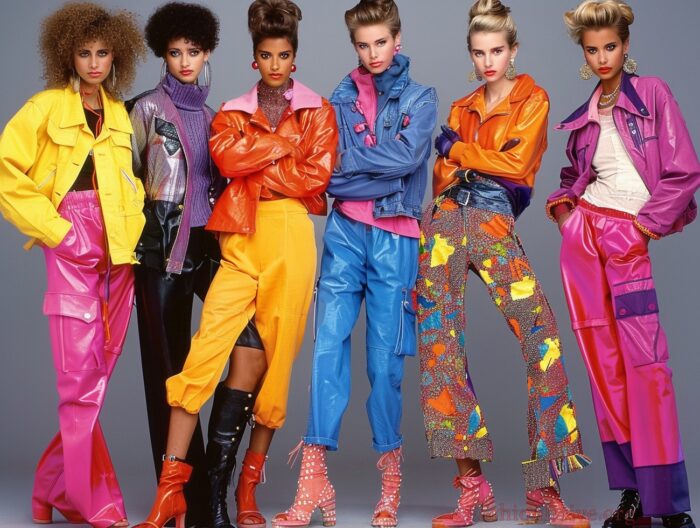
Activewear Goes Mainstream: The Fitness Craze
The 1980s saw a fitness boom that profoundly impacted fashion. I find this trend particularly interesting because it blurs the lines between workout clothes and everyday wear.
Leotards, leg warmers, and headbands became ubiquitous, worn not only in gyms but also on the streets. Several factors drove this trend:
- The rise of aerobics and home workout videos
- Increasing focus on health and fitness
- Celebrities promoting active lifestyles
Sweat is fat crying.
This popular 80s saying encapsulates the decade’s fitness obsession, which directly influenced fashion choices.
Athletic brands like Nike and Reebok saw explosive growth during this period. They expanded beyond traditional sports shoes to create entire lines of fashionable activewear.
Key elements of 80s activewear included:
- High-cut leotards
- Colorful spandex shorts and tights
- Oversized T-shirts and sweatshirts
- Chunky sneakers
The influence of workout videos can’t be overstated. Fitness gurus like Jane Fonda and Richard Simmons became style icons, their colorful, form-fitting outfits inspiring millions.
This trend also marked a shift towards more body-conscious fashion. Tight, stretchy fabrics highlighted physiques, reflecting the era’s focus on sculpted bodies.
Interestingly, many of these activewear pieces found their way into everyday fashion. It wasn’t uncommon to see people wearing leggings or sweatbands with regular outfits, a trend that presaged today’s athleisure movement in many ways.
The 80s fitness fashion craze left a lasting impact on how we view comfort and functionality in clothing. It paved the way for the acceptance of casual, comfortable clothing in various settings beyond the gym.
New Romanticism: The Flamboyant Subculture
I am fascinated by the New Romantic movement of the 1980s. This subculture emerged from the UK club scene and quickly influenced global fashion trends. It represented a dramatic shift from the stark, anti-fashion ethos of punk.
The New Romantic style embraced flamboyance and theatricality. Key elements included:
- Frilly shirts with ruffled collars
- Elaborate hairstyles
- Dramatic makeup for both men and women
Style is a way to say who you are without having to speak.
This quote perfectly captures the essence of New Romantic fashion. It was all about self-expression through bold, eye-catching outfits.
The movement drew inspiration from various historical periods, particularly the Romantic era of the early 19th century. This resulted in a unique blend of historical and futuristic elements:
| Historical Elements | Futuristic Touches |
|---|---|
| Poet shirts | Metallic fabrics |
| Brocade jackets | Innovative hair dyes |
| Victorian-style boots | Synthesizer-inspired accessories |
Androgyny played a significant role in New Romantic fashion. Men often wore makeup and feminine clothing, while women adopted traditionally masculine styles. This blurring of gender lines was revolutionary for its time.
Bands like Duran Duran and Adam and the Ants popularized the New Romantic look. Their music videos showcased elaborate costumes that fans eagerly emulated.
Colors were rich and varied, with a preference for:
- Deep purples
- Shimmering golds
- Vibrant reds
- Stark blacks
While relatively short-lived, the New Romantic movement left a lasting impact on fashion. Its influence can still be seen in contemporary haute couture and theatrical stage wear.
Punk and Gothic: The Dark Side of 80s Fashion
While New Romanticism celebrated excess, the punk and gothic subcultures of the 1980s embraced a darker, more rebellious aesthetic. As someone who’s studied fashion history extensively, I find these movements particularly intriguing for their DIY ethos and anti-establishment stance.
Punk fashion, which originated in the late 70s, continued to evolve in the 80s. Key elements included:
- Leather jackets adorned with studs and patches
- Ripped clothing held together with safety pins
- Band t-shirts, often customized or hand-painted
- Mohawk hairstyles and vibrant, unnatural hair colors
Fashion is the armor to survive the reality of everyday life.
This quote resonates strongly with the punk movement, where clothing served as a form of protection against societal norms and expectations.
Gothic fashion, which emerged from the post-punk scene, shared some elements with punk but developed its own distinct style:
- All-black outfits
- Victorian-inspired clothing
- Heavy, dramatic makeup
- Occult symbols in jewelry and accessories
Both punk and gothic styles emphasized a DIY aesthetic. Followers often created or modified their own clothing, rejecting mass-produced fashion.
The makeup for both subcultures was dramatic and distinctive:
| Punk Makeup | Gothic Makeup |
|---|---|
| Bright, clashing colors | Pale foundation |
| Smeared or messy application | Dark, smoky eyes |
| Unconventional patterns | Black or deep red lipstick |
Music played a crucial role in shaping these fashion movements. Bands like The Cure, Siouxsie and the Banshees, and The Sisters of Mercy became style icons for the gothic scene, while punk bands like The Clash continued to influence fashion throughout the 80s.
The impact of punk and gothic fashion extended beyond their respective subcultures. Elements of these styles were incorporated into mainstream fashion, paving the way for alternative fashion in subsequent decades.
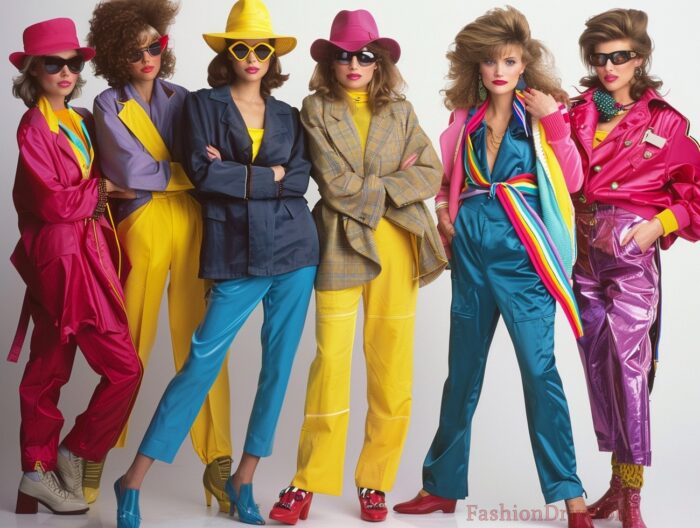
Madonna’s Influence: The Material Girl Effect
Madonna‘s impact on 1980s fashion cannot be overstated. I’ve observed how her ever-changing style influenced millions of fans worldwide. She became a trendsetter par excellence, pushing boundaries and challenging conventional notions of femininity.
Express yourself, don’t repress yourself.
This quote encapsulates Madonna’s approach to fashion and her influence on 80s style. She encouraged bold self-expression through clothing.
Key elements of Madonna’s 1980s look included:
- Lace gloves
- Crucifix jewelry
- Mesh tops
- Fishnet stockings
- Layered necklaces
Perhaps her most controversial trend was wearing underwear as outerwear. Madonna popularized corsets, bustiers, and bras worn as tops, challenging societal norms and redefining sexy.
Her influence extended to hairstyles and makeup:
| Hair | Makeup |
|---|---|
| Bleached blonde | Bold red lips |
| Messy, teased | Heavy eyeliner |
| Scrunchies | Beauty mark |
Madonna’s style evolved rapidly throughout the decade. She drew inspiration from various sources, including:
- Punk subculture
- Hispanic culture
- 1950s Hollywood glamour
- Religious imagery
Her ability to mix high-fashion items with streetwear created a unique aesthetic that many tried to emulate. Designers quickly caught on, and “Madonna-inspired” clothing lines became common in retail stores.
The “Material Girl” didn’t restrict herself to one style. Instead, she constantly reinvented her image, keeping fans and fashion enthusiasts on their toes. This chameleon-like approach to fashion became a hallmark of 80s style, encouraging experimentation and individual expression.
Preppy Style: The Conservative Look
While Madonna and punk rockers were pushing fashion boundaries, the preppy style offered a more conservative alternative. This look, rooted in the dress codes of Northeastern U.S. prep schools, gained widespread popularity in the 1980s.
You can never be overdressed or overeducated.
This sentiment perfectly captures the preppy ethos, which valued a polished, educated appearance.
Key elements of the preppy look included:
- Polo shirts (often with popped collars)
- Khaki pants
- Sweaters tied around shoulders
- Loafers or boat shoes
Colors played a crucial role in preppy fashion. Pastels and bright hues were popular, especially in combination:
| Tops | Bottoms |
|---|---|
| Pink | Kelly green |
| Light blue | Khaki |
| Yellow | Navy |
Brands like Ralph Lauren, Lacoste, and L.L.Bean became synonymous with the preppy look. Their logos, often prominently displayed, became status symbols.
Preppy accessories completed the look:
- Pearl necklaces for women
- Leather belts with nautical motifs
- Classic watches
- Headbands
The preppy style wasn’t limited to casual wear. For more formal occasions, preppy fashion dictated:
- Blazers with gold buttons
- Plaid or madras patterns
- Oxford shirts
- A-line skirts for women
This look represented a return to traditional values in fashion, contrasting sharply with some of the decade’s more outrageous trends. It appealed to those seeking a clean-cut, affluent image.
Interestingly, elements of the preppy style were sometimes co-opted and subverted by other subcultures. Hip-hop artists, for example, occasionally wore preppy brands in oversized, non-traditional ways.
The preppy look of the 1980s continues to influence fashion today. Its clean lines and classic pieces have become timeless staples in many wardrobes.
Hip-hop Fashion: From the Streets to Global Trend
Hip-hop fashion in the 1980s revolutionized street style and eventually influenced mainstream fashion worldwide. I’ve seen how this cultural movement created a unique aesthetic that continues to shape trends today.
Style is a way to say who you are without having to speak.
This quote perfectly encapsulates how hip-hop fashion became a form of self-expression and cultural identity.
Key elements of 80s hip-hop style included:
- Oversized clothing
- Gold chains and medallions
- Branded tracksuits
- Sneakers, especially high-tops
Hip-hop artists like Run-DMC played a crucial role in popularizing certain brands. Their influence on fashion was so significant that it led to the first endorsement deal between a hip-hop group and a major clothing company.
| Brand | Associated Item |
|---|---|
| Adidas | Shell-toe sneakers |
| Kangol | Bucket hats |
| Cazal | Oversized glasses |
The style was about more than clothes; it encompassed an entire look:
- Bold gold jewelry
- Fresh haircuts (fades, flat tops)
- Customized jackets
- Athletic team logos
Hip-hop fashion challenged traditional notions of luxury. Sportswear and casual clothes became status symbols when worn by influential artists. This shift marked a democratization of fashion, making style more accessible to urban youth.
Colors in hip-hop fashion were often bold and contrasting. Black, white, and red were popular, as were neon accents that aligned with broader 80s trends.
By the end of the decade, hip-hop fashion had moved from the streets to the global stage, influencing designers and retailers worldwide.
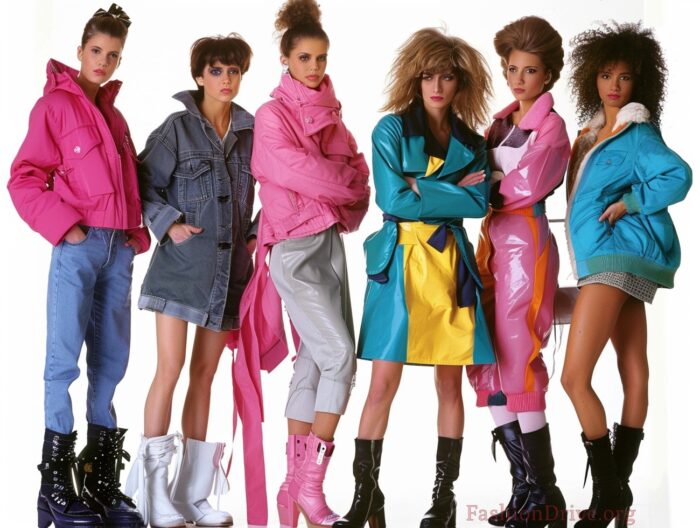
Hairstyles and Makeup: Big Hair and Bold Looks
The 1980s were an era of excess, and nowhere was this more evident than in hairstyles and makeup. As someone who’s studied fashion history extensively, I find the dramatic looks of this decade particularly fascinating.
The higher the hair, the closer to God.
This humorous quote captures the 80s obsession with big, voluminous hair.
Popular 80s hairstyles included:
- Perms
- Mullets
- Side ponytails
- Crimped hair
For both men and women, the goal was often to achieve maximum volume. This led to the heavy use of hairspray, mousse, and gel.
Makeup in the 80s was equally bold:
| Eyes | Cheeks | Lips |
|---|---|---|
| Bright eyeshadow | Heavy blush | Bold colors |
| Blue mascara | Contoured cheekbones | Glossy finishes |
The 1980s saw an explosion of color in makeup. Eyeshadow in vivid blues, purples, and pinks was common, often extending all the way up to the eyebrows.
Men’s grooming also evolved during this decade:
- Facial hair became more acceptable in professional settings
- Male-specific skincare products gained popularity
- Some men began experimenting with makeup, influenced by rock stars
Celebrities played a huge role in popularizing certain looks. Farrah Fawcett’s feathered hair, Boy George’s androgynous makeup, and Michael Jackson’s Jheri curl became iconic styles of the era.
The 80s approach to hair and makeup was all about making a statement. Subtlety was out, and bold self-expression was in. This ethos aligned perfectly with the decade’s fashion trends, creating cohesive looks that were unmistakably ’80s’.
While some of these styles might seem over-the-top today, they’ve left a lasting impact on beauty trends. The experimentation and creativity of 80s hair and makeup paved the way for the diverse beauty landscape we see today.
Accessories: The Bigger, the Better
In the 1980s, accessories took center stage in fashion. I’ve always been fascinated by how these elements could make or break an outfit during this era. The mantra for 80s accessories was clear: bigger is better.
Accessories are like vitamins to fashion – as such, you should use them liberally.
This quote perfectly encapsulates the 80s approach to accessorizing. Nothing was too bold or too much.
Key accessory trends included:
- Chunky jewelry
- Large, dangling earrings
- Wide belts
- Statement sunglasses
Jewelry in the 80s was all about making a statement. Gold was particularly popular, often in oversized forms:
| Jewelry Item | Typical 80s Style |
|---|---|
| Necklaces | Multiple chains, often layered |
| Bracelets | Thick bangles, worn in multiples |
| Earrings | Large hoops or geometric shapes |
Belts became a focal point of many outfits. Wide, statement belts cinched waists and added drama to both casual and formal looks. Materials ranged from leather to elastic, often adorned with large, eye-catching buckles.
Sunglasses in the 80s were rarely subtle. Popular styles included:
- Aviators
- Oversized frames
- Brightly colored plastics
- Futuristic shapes
Hair accessories also played a significant role. Scrunchies, headbands, and large bows were ubiquitous. These items often matched outfits and were used to create voluminous hairstyles characteristic of the era.
The 80s saw accessories as a way to personalize and elevate any outfit. From power suits to casual wear, the right accessories could transform a look. This maximalist approach to accessorizing reflected the decade’s overall ethos of excess and self-expression.
Formal Wear: Prom and Party Fashion
Formal wear in the 1980s was a spectacle of extravagance and glamour. As someone who’s studied fashion history, I find the prom and party styles of this era particularly intriguing. They embodied the decade’s love for drama and excess.
Dress shabbily and they remember the dress; dress impeccably and they remember the woman.
This quote reflects the importance placed on making a lasting impression through formal wear in the 80s.
Key elements of 80s formal fashion included:
- Puffy sleeves
- Ruffled dresses
- Taffeta and sequin fabrics
- Bold colors and patterns
For women, prom dresses often featured:
- Off-the-shoulder designs
- Sweetheart necklines
- Voluminous skirts
- Lots of ruffles and bows
Men’s formal wear wasn’t left behind in the trend for extravagance. Tuxedos often included:
| Element | 80s Style |
|---|---|
| Jacket | Broader shoulders, sometimes in bold colors |
| Shirt | Ruffled fronts |
| Bow tie | Oversized, matching cummerbund |
| Pants | High-waisted, pleated |
Colors played a crucial role in 80s formal wear. While black remained a classic choice, vibrant hues, and pastels were equally popular. Neon colors even made their way into formal attire, reflecting the decade’s overall fashion trends.
Accessories completed the formal look:
- Elbow-length gloves for women
- Corsages and boutonnieres
- Ornate costume jewelry
- Small, decorative purses
Hairstyles for formal events were often elaborate, with updos, curls, and lots of hairspray being the norm. Men often sported slicked-back looks or the popular mullet style.
The influence of celebrities and pop culture on formal wear was significant. Prom-goers often emulated the styles seen in popular movies and on music awards shows.
80s formal wear was all about creating a memorable, larger-than-life look. While these styles might seem over-the-top by today’s standards, they captured the spirit of an era that celebrated boldness and individuality in fashion.
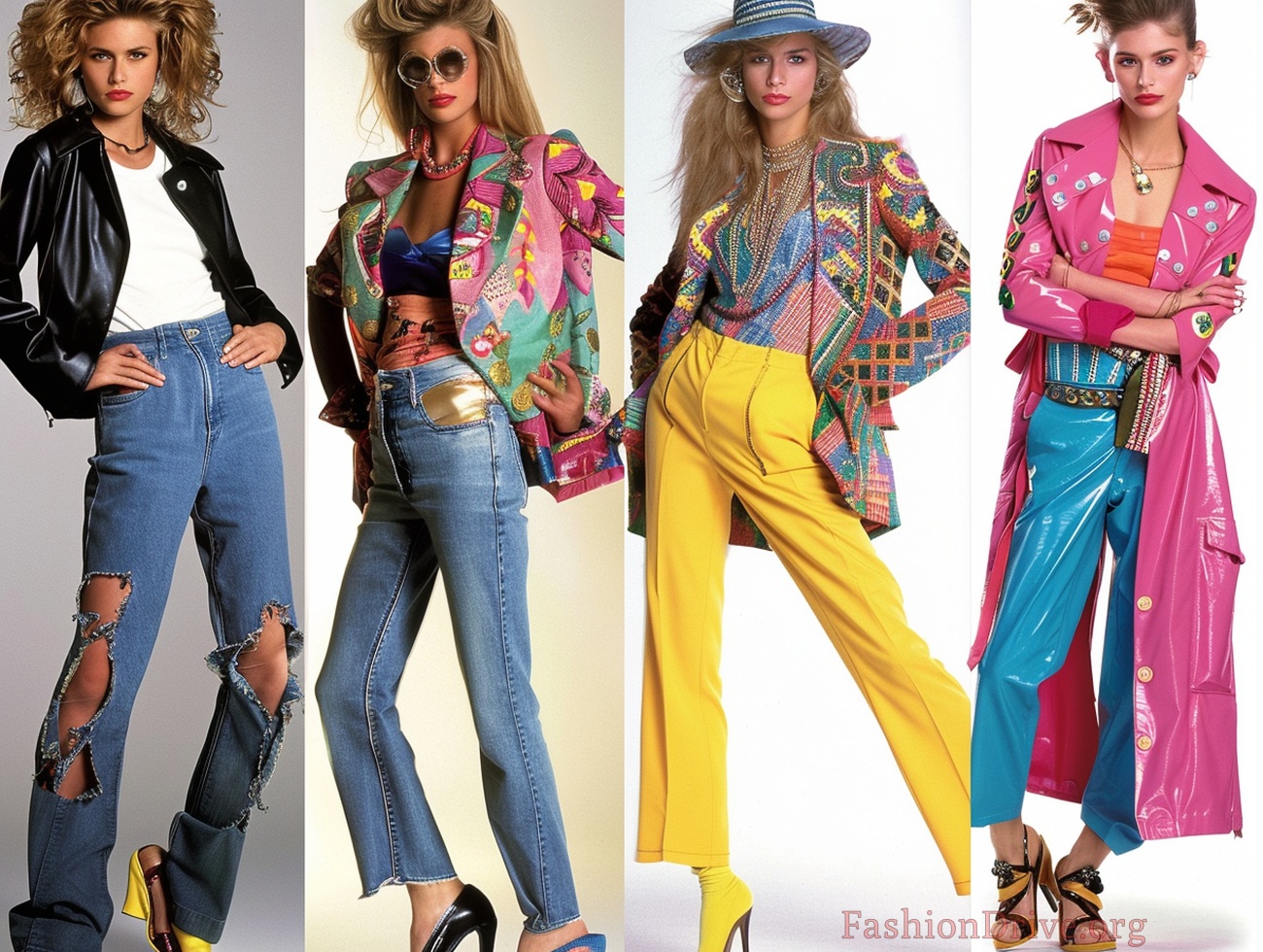
Iconic Movie Influences: Hollywood’s Fashion Impact
The 1980s saw a strong interplay between cinema and fashion. I’ve always been fascinated by how movies of this era shaped real-world style trends. Hollywood’s influence on 80s fashion was profound and far-reaching.
Life imitates art far more than art imitates life.
This quote perfectly captures how 80s movies inspired everyday fashion choices.
Several films had a particularly significant impact:
- “Flashdance” (1983)
- “Top Gun” (1986)
- “Miami Vice” (TV series, 1984-1990)
“Flashdance” popularized the off-shoulder sweatshirt look. This trend quickly spread beyond the dance studio:
| Item | How it was worn |
|---|---|
| Sweatshirts | Cut at the neckline, worn off one shoulder |
| Leg warmers | Paired with everything from jeans to skirts |
| Headbands | Wide, often in bright colors |
“Top Gun” made aviator sunglasses and leather bomber jackets must-have items. The film’s military-inspired look influenced both men’s and women’s fashion:
- Ray-Ban aviator sunglasses saw a huge surge in popularity
- Bomber jackets became a staple casual outerwear piece
- White t-shirts and blue jeans gained a new cool factor
“Miami Vice” had a massive impact on men’s fashion in particular. The show’s stylish detectives popularized:
- Pastel-colored suits
- T-shirts under blazers
- Loafers worn without socks
- Stubble as a deliberate facial hair style
Other influential 80s movies included “The Breakfast Club,” which showcased various teen subcultures, and “Desperately Seeking Susan,” which helped popularize Madonna’s eclectic style.
These films did more than showcase fashion – they made certain looks feel aspirational and cool. They connected clothing choices to lifestyles and identities, influencing how people dressed in their everyday lives.
Global Fashion Influences: International Trends
The 1980s saw fashion become truly global, with influences flowing from various parts of the world into mainstream Western style. As someone who’s studied fashion history extensively, I find this cross-cultural exchange fascinating.
Fashion is not something that exists in dresses only. Fashion is in the sky, in the street; fashion has to do with ideas, the way we live, what is happening.
This quote beautifully expresses how 80s fashion drew inspiration from diverse global sources.
Japanese street style had a significant impact on 80s fashion:
- Avant-garde designers like Yohji Yamamoto and Rei Kawakubo brought new silhouettes to Western fashion
- The “Harajuku” style began to gain international attention
- Technological advancements in fabric from Japan influenced global fashion
European high fashion continued to be influential:
| Country | Notable Contributions |
|---|---|
| Italy | Versace’s bold prints, Armani’s power suits |
| France | Chanel’s revival under Karl Lagerfeld |
| UK | Vivienne Westwood’s punk-inspired designs |
Australian and British fashion exports also made their mark:
- The success of “Crocodile Dundee” popularized Australian outback fashion
- British bands like Duran Duran influenced men’s fashion globally
- Princess Diana became a global fashion icon, influencing women’s styles
Other global influences included:
- African prints and textiles are gaining popularity in Western fashion.
- Indian-inspired accessories like bangle bracelets are becoming trendy.
- Latin American influences are seen in ruffled skirts and off-shoulder tops.
The 1980s also saw the rise of global fashion brands. Companies like Benetton and Esprit promoted a multicultural image that resonated with the increasingly connected world.
This decade marked a shift towards a more diverse, globally-influenced fashion landscape. It set the stage for the even more interconnected fashion world we see today, where trends can originate from any corner of the globe and quickly spread worldwide.
Conclusion
The 1980s left an indelible mark on fashion history. I’ve seen how the styles of this decade continue to influence contemporary trends. Bold choices, diverse influences, and a spirit of experimentation characterized the 80s fashion.
Fashion fades, only style remains the same.
This quote reflects the lasting impact of 80s fashion. While specific trends may come and go, the decade’s emphasis on self-expression through clothing endures.
Key aspects of 80s fashion that continue to resonate today include:
- Bold color choices
- The mix of high-end and street styles
- Emphasis on accessories
- Influence of music and pop culture on fashion
In the 1980s, fashion became more democratic and diverse. Subcultures gained mainstream attention, and personal style became a form of self-expression for many.
| 80s Trend | Modern Interpretation |
|---|---|
| Power dressing | Updated tailoring in womenswear |
| Neon colors | Pops of bright color in accessories |
| Oversized silhouettes | Relaxed, comfortable fits |
| Logomania | Revival of branded items |
The decade’s fashion also reflected broader societal changes:
- Women’s increasing presence in the workplace influenced professional attire
- Music videos created new platforms for showcasing and influencing style
- Globalization led to more diverse fashion influences
Looking back, 80s fashion might seem excessive or dated to some. However, its impact on how we approach style today is undeniable. The decade taught us to be bold, to mix high and low fashion, and to use clothing as a form of personal expression.
The cyclical nature of fashion ensures that elements of 80s style regularly resurface in contemporary trends. As we continue to draw inspiration from this vibrant decade, we’re reminded of fashion’s power to reflect and shape culture.

